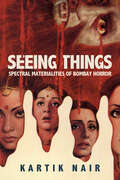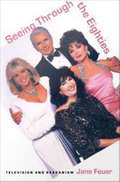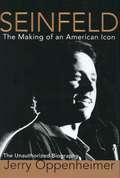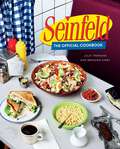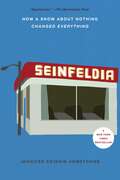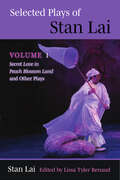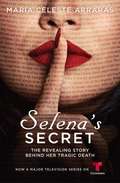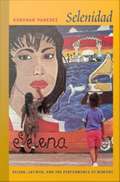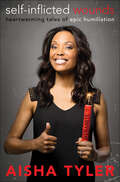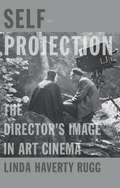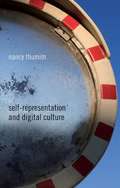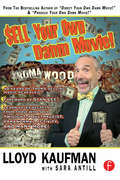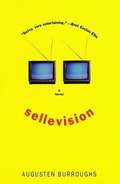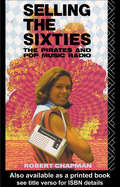- Table View
- List View
Seeing Things
by Alan AckermanA technological revolution has changed the way we see things. The storytelling media employed by Pixar Animation Studios, Samuel Beckett, and William Shakespeare differ greatly, yet these creators share a collective fascination with the nebulous boundary between material objects and our imaginative selves. How do the acts of seeing and believing remain linked? Alan Ackerman charts the dynamic history of interactions between showing and knowing in Seeing Things, a richly interdisciplinary study which illuminates changing modes of perception and modern representational media.Seeing Things demonstrates that the airy nothings of A Midsummer Night's Dream, the Ghost in Hamlet, and soulless bodies in Beckett's media experiments, alongside Toy Story's digitally animated toys, all serve to illustrate the modern problem of visualizing, as Hamlet put it, 'that within which passes show.' Ackerman carefully analyses such ghostly appearances and disappearances across cultural forms and contexts from the early modern period to the present, investigating the tension between our distrust of shadows and our abiding desire to believe in invisible realities. Seeing Things provides a fresh and surprising cultural history through theatrical, verbal, pictorial, and cinematic representations.
Seeing Things: Spectral Materialities of Bombay Horror (South Asia Across the Disciplines)
by Kartik NairIn 1980s India, the Ramsay Brothers and other filmmakers produced a wave of horror movies about soul-sucking witches, knife-wielding psychopaths, and dark-caped vampires. Seeing Things is about the sudden cuts, botched makeup effects, continuity errors, and celluloid damage found in these movies. Kartik Nair reads such "failures" as clues to the conditions in which the films were made, censored, and seen, offering a view from below of the world's largest film culture. By combining close analysis with extensive archival research and original interviews, Seeing Things reveals the spectral materialities informing the genre's haunted houses, grotesque bodies, and graphic violence.
Seeing Through the Eighties: Television and Reaganism
by Jane FeuerThe 1980s saw the rise of Ronald Reagan and the New Right in American politics, the popularity of programs such as thirtysomething and Dynasty on network television, and the increasingly widespread use of VCRs, cable TV, and remote control in American living rooms. In Seeing Through the Eighties, Jane Feuer critically examines this most aesthetically complex and politically significant period in the history of American television in the context of the prevailing conservative ideological climate. With wit, humor, and an undisguised appreciation of TV, she demonstrates the richness of this often-slighted medium as a source of significance for cultural criticism and delivers a compelling decade-defining analysis of our most recent past. With a cast of characters including Michael, Hope, Elliot, Nancy, Melissa, and Gary; Alexis, Krystle, Blake, and all the other Carringtons; not to mention Maddie and David; even Crockett and Tubbs, Feuer smoothly blends close readings of well-known programs and analysis of television's commercial apparatus with a thorough-going theoretical perspective engaged with the work of Baudrillard, Fiske, and others. Her comparative look at Yuppie TV, Prime Time Soaps, and made-for-TV-movie Trauma Dramas reveals the contradictions and tensions at work in much prime-time programming and in the frustrations of the American popular consciousness. Seeing Through the Eighties also addresses the increased commodification of both the producers and consumers of television as a result of technological innovations and the introduction of new marketing techniques. Claiming a close relationship between television and the cultures that create and view it, Jane Feuer sees the eighties through televison while seeing through television in every sense of the word.
Seeing Through: A Chronicle of Sex, Drugs, and Opera
by Ricky Ian GordonThe true confessions of a working opera composer: an exhilarating story of "a life that comes out of chaos." At eight years old, Ricky Ian Gordon pulled The Victor Book of Opera off his piano teacher’s bookshelf, and his world shifted on its axis. Though scandal, sadness, and confusion would shake that world over the next few decades, its polestar remained constant. Music has been the guiding force of Gordon’s life; through it, he has been able not only to survive great sorrow but also to capture the depths of his emotion in song. It is this strength, this technical and visceral genius, that has made him one of our generation’s greatest composers.In Seeing Through, Gordon writes with humor, insight, and incredible candor about his life and work: a tumultuous youth on Long Island, his artistic collaborations and obsessions, the creation of his compositions (including The Grapes of Wrath, 27, Orpheus and Euridice, Intimate Apparel, Ellen West, and more), his addictions and the abuses he endured, and the loss of his partner to AIDS and the devastation of the HIV/AIDS epidemic. As Gordon writes of that period: “We were, thousands of us, Lazarus. We had to rise from the ashes. We didn’t have to rebuild our lives, we had to build new ones.” Gordon has succeeded in building a remarkable life, as well as a body of work that bears witness to all he survived in the process—one that will endure as a pivotal chapter in America's songbook.
Seeing as Practice: Philosophical Investigations into the Relation Between Sight and Insight (Performance Philosophy)
by Eva SchuermannThis study provides an overview of philosophical questions relating to sight and vision. It discusses the intertwinement of seeing and ways of seeing against the background of an entirely different theoretical framework.Seeing is both a proven means of acquiring information and a personality-specific way of disclosing the apparent, perceptible world, conditioned by individual and cultural variations. In a peculiar way, the eye holds a middle position between inside and outside of the self and its relations towards itself and others. This book provides a way out of false alternatives by offering a third way with reference to concrete cases of aesthetical and ethical experiences. It will be of particular interest to scholars of the phenomenology and philosophy of perception and it will be valuable to students of philosophy, cultural studies and art.
Seeing from Scratch: Fifteen Lessons with Godard
by Richard DienstTaking as his starting point fifteen characteristically penetrating epigrams by Jean-Luc Godard, Richard Dienst invites us to trace a new path through some of the fundamental questions of cinema. Godard has never stopped offering lessons about seeing and thinking, always insisting that we have to learn how to start over. By starting over "from scratch," Godard challenges us to rethink our ideas about embodied perception, material form and the politics of making images. Less a commentary on Godard's oeuvre than an outline of a Godardian pedagogy, Seeing from Scratch offers a theoretical exercise book for students, teachers and practitioners alike, pursuing unexpectedly far-reaching ways to think through images. Along the way we encounter, in this brief, accessible essay, ideal for classroom use, a wide range of thinkers whose ideas are put to use working through the intellectual and aesthetic questions and challenges Godard's epigrams suggest – not in the abstract, but as part of the book's practical approach to intellectual problem solving. In its conversational tone, return to fundaments and practical pedagogical approach, Seeing from Scratch is an essay for the media age in the mould of John Berger's Ways of Seeing from the 1970s: a new way of discussing the theory and practice of images and the film image. A companion piece, "The Postcard Game," presents a scene from an imaginary classroom, where a stack of postcards – like those found throughout Godard's work – provokes a spiralling series of questions about images, texts and the manifold pathways of the creative process.
Seeing from Scratch: Fifteen Lessons with Godard
by Richard DienstTaking as his starting point fifteen characteristically penetrating epigrams by Jean-Luc Godard, Richard Dienst invites us to trace a new path through some of the fundamental questions of cinema. Godard has never stopped offering lessons about seeing and thinking, always insisting that we have to learn how to start over. By starting over "from scratch," Godard challenges us to rethink our ideas about embodied perception, material form and the politics of making images. Less a commentary on Godard's oeuvre than an outline of a Godardian pedagogy, Seeing from Scratch offers a theoretical exercise book for students, teachers and practitioners alike, pursuing unexpectedly far-reaching ways to think through images. Along the way we encounter, in this brief, accessible essay, ideal for classroom use, a wide range of thinkers whose ideas are put to use working through the intellectual and aesthetic questions and challenges Godard's epigrams suggest – not in the abstract, but as part of the book's practical approach to intellectual problem solving. In its conversational tone, return to fundaments and practical pedagogical approach, Seeing from Scratch is an essay for the media age in the mould of John Berger's Ways of Seeing from the 1970s: a new way of discussing the theory and practice of images and the film image. A companion piece, "The Postcard Game," presents a scene from an imaginary classroom, where a stack of postcards – like those found throughout Godard's work – provokes a spiralling series of questions about images, texts and the manifold pathways of the creative process.
SeinLanguage
by Jerry SeinfeldThose who have watched Jerry Seinfeld's shows will hear his voice in this humorous writing.
Seinfeld: The Making of an American Icon
by Jerry OppenheimerThe never-before-told story of how Jerry Seinfeld made his dream come true -- of how this very ambitious, extremely driven, compulsively perfectionistic carefully worked his way up through the knock-down-drag-out world of stand-up comedy as it began to explode in the mid-1970s, & how he went on to co-create in the late 80s what is considered to be the most successful TV sitcom in its history. From the start, Jerry has been extremely private about all aspects of his personal life. For more than a year, Oppenheimer conducted in-depth interviews with scores of Jerry s closes friends, family members, bus. assoc., lovers, & fellow comedians who spoke candidly, painting a riveting portrait of the beloved & talented comedian.
Seinfeld: The Official Cookbook
by Insight EditionsA Simon & Schuster eBook. Simon & Schuster has a great book for every reader.
Seinfeldia: How a Show About Nothing Changed Everything
by Jennifer Keishin Armstrong"Her book, as if she were a marine biologist, is a deep dive...Perhaps the highest praise I can give Seinfeldia is that it made me want to buy a loaf of marbled rye and start watching again, from the beginning." --Dwight Garner, The New York Times Book Review The hilarious behind-the-scenes story of two guys who went out for coffee and dreamed up Seinfeld--the cultural sensation that changed television and bled into the real world, altering the lives of everyone it touched.Comedians Larry David and Jerry Seinfeld never thought anyone would watch their silly little sitcom about a New York comedian sitting around talking to his friends. NBC executives didn't think anyone would watch either, but they bought it anyway, hiding it away in the TV dead zone of summer. But against all odds, viewers began to watch, first a few and then many, until nine years later nearly forty million Americans were tuning in weekly. In Seinfeldia, acclaimed TV historian and entertainment writer Jennifer Keishin Armstrong celebrates the creators and fans of this American television phenomenon, bringing readers behind-the-scenes of the show while it was on the air and into the world of devotees for whom it never stopped being relevant, a world where the Soup Nazi still spends his days saying "No soup for you!", Joe Davola gets questioned every day about his sanity, Kenny Kramer makes his living giving tours of New York sights from the show, and fans dress up in Jerry's famous puffy shirt, dance like Elaine, and imagine plotlines for Seinfeld if it were still on TV.
Selected Correspondence of Charles Ives
by Tom C. OwensThis volume of 453 letters written by and to composer Charles Ives (1874-1954) provides an insight into one of the most extraordinary and paradoxical careers in American music history. This book opens a direct window on Ives's complex personality and his creative process.
Selected Plays of Stan Lai: Volume 1: Secret Love in Peach Blossom Land and Other Plays
by Stan LaiStan Lai (Lai Shengchuan) is one of the most celebrated theatre practitioners working in the Chinese-speaking world. His work over three decades has pioneered the course of modern Chinese language theatre in Taiwan, China, and other Chinese speaking regions. "The preeminent Chinese playwright and stage director of this generation." (China Daily) "The best Chinese language playwright and director in the world." (BBC) Lai's works include masterpieces of the modern Chinese language theatre like Secret Love in Peach Blossom Land, The Village, and his epic 8 hour A Dream Like A Dream, all of which are in this collection. These volumes feature works from across Lai’s career, providing an exceptional selection of a diverse range of performances. Volume One contains: Secret Love in Peach Blossom Land Look Who's Crosstalking Tonight The Island and the Other Shore I Me She Him Ménage à 13
Selected Plays of Stan Lai: Volume 2: The Village and Other Plays
by Stan LaiStan Lai (Lai Shengchuan) is one of the most celebrated theatre practitioners working in the Chinese-speaking world. His work over three decades has pioneered the course of modern Chinese language theatre in Taiwan, China, and other Chinese speaking regions. "The preeminent Chinese playwright and stage director of this generation." (China Daily) "The best Chinese language playwright and director in the world." (BBC) Lai's works include masterpieces of the modern Chinese language theatre like Secret Love in Peach Blossom Land, The Village, and his epic 8 hour A Dream Like A Dream, all of which are in this collection. These volumes feature works from across Lai’s career, providing an exceptional selection of a diverse range of performances. Volume Two contains: Millennium Teahouse Sand on a Distant Star Like Shadows The Village Writing in Water
Selected Plays of Stan Lai: Volume 3: A Dream Like a Dream and Ago
by Stan LaiStan Lai (Lai Shengchuan) is one of the most celebrated theatre practitioners working in the Chinese-speaking world. His work over three decades has pioneered the course of modern Chinese language theatre in Taiwan, China, and other Chinese speaking regions. "The preeminent Chinese playwright and stage director of this generation." (China Daily) "The best Chinese language playwright and director in the world." (BBC) Lai's works include masterpieces of the modern Chinese language theatre like Secret Love in Peach Blossom Land, The Village, and his epic 8 hour A Dream Like A Dream, all of which are in this collection. These volumes feature works from across Lai’s career, providing an exceptional selection of a diverse range of performances. Volume Three contains: A Dream Like a Dream Ago
Selena's Secret: The Revealing Story Behind Her Tragic Death
by María Celeste Arrarás20th Anniversary Edition An intimate and investigative portrait of beloved Mexican American singer Selena Quintanilla’s murder by Emmy Award-winning journalist María Celeste Arrarás. Now with a new foreword and afterword by the author for the 20th Anniversary Edition.There is no doubt that Yolanda Saldívar pulled the trigger and killed Tejano superstar Selena Quintanilla Pérez on March 31, 1995. But does anyone know what really happened in Room 158 of the Days Inn, moments before the crime took place? María Celeste Arrarás has many answers, and her unrivaled coverage of the murder, trial, and aftermath made her the undisputed expert on the Selena case. Arrarás shares firsthand information about the crime and the people involved—including details of her headline-making jailhouse interview with Yolanda, who repeatedly spoke of “Selena’s secret”—a powerful hidden piece of information that she refused to divulge in the courtroom but revealed to Arrarás at length. Many questions were raised, and not all were answered until this revealing interview shed light on the crime. Why was there a suitcase filled with Selena’s clothes at the murder scene? What was the significance of the jeweled ring, adorned with the initial S that fell from Selena’s bloody fist? Who was the doctor from Monterrey who called himself Selena’s confidant and business adviser? Selena’s Secret fits together the pieces of this puzzle and depicts what really happened on that rainy day in March.
Selenidad: Selena, Latinos, and the Performance of Memory
by Deborah ParedezAn outpouring of memorial tributes and public expressions of grief followed the death of the Tejana recording artist Selena Quintanilla Prez in 1995. The Latina superstar was remembered and mourned in documentaries, magazines, websites, monuments, biographies, murals, look-alike contests, musicals, drag shows, and more. Deborah Paredez explores the significance and broader meanings of this posthumous celebration of Selena, which she labels "Selenidad. " She considers the performer's career and emergence as an icon within the political and cultural transformations in the United States during the 1990s, a decade that witnessed a "Latin explosion" in culture and commerce alongside a resurgence of anti-immigrant discourse and policy. Paredez argues that Selena's death galvanized Latina/o efforts to publicly mourn collective tragedies (such as the murders of young women along the U. S. -Mexico border) and to envision a brighter future. At the same time, reactions to the star's death catalyzed political jockeying for the Latino vote and corporate attempts to corner the Latino market. Foregrounding the role of performance in the politics of remembering, Paredez unravels the cultural, political, and economic dynamics at work in specific commemorations of Selena. She analyzes Selena's final concert, the controversy surrounding the memorial erected in the star's hometown of Corpus Christi, and the political climate that served as the backdrop to the touring musicals Selena Forever and Selena: A Musical Celebration of Life. Paredez considers what "becoming" Selena meant to the young Latinas who auditioned for the biopic Selena, released in 1997, and she surveys a range of Latina/o queer engagements with Selena, including Latina lesbian readings of the star's death scene and queer Selena drag. Selenidad is a provocative exploration of how commemorations of Selena reflected and changed Latinidad.
Self-Inflicted Wounds: Heartwarming Tales of Epic Humiliation
by Aisha TylerEmmy Award–winner Aisha Tyler shares her Self-Inflicted Wounds of epic mistakes through hilarious stories—and the life lessons she gained along the way.Refreshingly and sometimes brutally honest, surprising, and laugh-out-loud funny, the essays in this collection from comedian and actress Aisha Tyler vividly translate the brand of humor she has cultivated through her successful standup career, as well as the strong voice and unique point of view she expresses as a talk show and podcast host. Freely admitting moments of crushing personal embarrassment, Aisha celebrates the personal insights and authentic wisdom she earned from her experiences. Riotous, revealing, and wonderfully relatable, Self-Inflicted Wounds: Heartwarming Tales of Epic Humiliation is about the power of calamity to shape life, learning, and success.
Self-Projection: The Director’s Image in Art Cinema
by Linda Haverty RuggIn 1957, a decade before Roland Barthes announced the death of the author, François Truffaut called for a new era in which films would &“resemble the person who made&” them and be &“even more personal&” than an autobiographical novel. More than five decades on, it seems that Barthes has won the argument when it comes to most film critics. The cinematic author, we are told, has been dead for a long time. Yet Linda Haverty Rugg contends not only that the art cinema auteur never died, but that the films of some of the most important auteurs are intensely, if complexly, related to the lives and self-images of their directors. Self-Projection explores how nondocumentary narrative art films create alternative forms of collaborative self-representation and selfhood.The book examines the work of celebrated directors who plant autobiographical traces in their films, including Truffaut, Bergman, Fellini, Tarkovsky, Herzog, Allen, Almodóvar, and von Trier. It is not simply that these directors, and many others like them, make autobiographical references or occasionally appear in their films, but that they tie their films to their life stories and communicate that link to their audiences. Projecting a new kind of selfhood, these directors encourage identifications between themselves and their work even as they disavow such connections. And because of the collaborative and technological nature of filmmaking, the director&’s self-projection involves actors, audience, and the machines and institution of the cinema as well.Lively and accessible, Self-Projection sheds new light on the films of these iconic directors and on art cinema in general, ultimately showing how film can transform not only the autobiographical act but what it means to have a self.
Self-Representation and Digital Culture
by Nancy ThumimTaking a close look at ordinary people 'telling their own story', Thumim explores self-representations in contemporary digital culture in settings as diverse as reality TV, online storytelling, and oral histories displayed in museums. Now available in paperback, Self-Representation and Digital Culture addresses the institutional contexts of production, technology and form of the texts, and the point of view of those who represent themselves. This highly original research examines how contradictory and widely different politics inform and shape examples of 'speaking for oneself'. In the book, Thumim argues that analysis and theorization of the activity of self-representation is vital for media, communication and cultural studies at a time when examples, of what should now be understood as a genre, both surround us and appear, at first glance, to all be alike.
Sell Your Own Damn Movie!
by Lloyd KaufmanThis is the 3rd volume in Mr. Kaufman's hilarious, how-to series for hard-working self-starters and hard-laughing, cheeky filmmakers. "Sell Your Own Damn Movie!" covers everything you need to do to get your finished film seen by festival-goers, movie-goers, DVD-buyers and web-goers around the world. You will be lead through a primer on the history of film distribution to a discussion of the many ways you can get your film out there, either through a reputable distributor or all on your own. From the realities of distribution, to utilizing the internet to self-distribution, Mr. Kaufman tells you in his habitually lucid and off-the-wall way. Inserts include interviews and pointers from veteran distribution pros as well as directors and producers who share their own front-line stories. Mr. Kaufman recounts his own raucous stories of marketing pleasures and nightmares from 35 years of movie-making experience, creating a uniquely useful and entertaining read. Or, in Lloyd's inimitable words. The most asked question at my worldwide popular, legendary, renowned master class is, "How do I get my no-budget, zombie giraffe flick distributed?†Well, have no fear, because the 3rd volume in Uncle Lloydie's how-to series of go-to guides for filmmakers reveals the secrets, methods and tricks (short of prostituting yourself and selling bodily organs) to getting your film distributed. With Troma, our legendary 35-year-old independent studio, Michael Herz and I have developed a low cost, high-impact method for low-budget film distribution, which has lead to a high-profile brand name and a catalog of over 800 titles! Now you can learn to get you movie out there, too. I will be your busty tour guide, sharing with you my hard-earned cinematic distribution know-how! -LEARN! How I achieved box office success with my fowl chicken zombie masterpiece Poultrygeist, and everyone's favorite super-human hero from New Jersey, the Toxic Avenger, for practically no money! -SMELL! The sewer that is mainstream distribution as I drag you through the muck, be-farting upon you the real scoop behind "indie†and mainstream distribution deals. -MASTICATE! (No, not that kind of masticating) On the knowledge of DVD distribution as I es-chew the fat and get to the skinny of Do-It-Yourself DVD distribution. I will teach you the fundamentals of having a good website (like www.Troma.com) to boost your sales! -FEAST! On my golden brown chicken puns as I cleverly cluck your brain out with the irrefutable knowledge of how I sold over 10,000 units of the 3-disc limited-edition Poultrygeist DVD in a matter of months! YES! If you have any doubt that I will not be able turn your no-budget zombie giraffe opus into box-office gold, then put down this book proposal! No wait, pick it back up, pick it back up! This is a recession damnit, Troma needs all the money we can, er... I need to educate you filmmakers looking for distribution gold (brown)! After reading my book, any damn filmmaker will be able to "Sell Your Own Damn Movie!†Featuring expert advice from those who have successfully sold their films: * David Cronenberg (Director of The Fly, Crash, A History of Violence)* Oren Peli (Director/Producer of Paranormal Activity)* Ted Hope (Producer of Crouching Tiger, Hidden Dragon, In the Bedroom, Happiness)* Brad Kembel (Executive Vice President of International Distribution at Summit Films; Twilight)* James Gunn (Writer/Director of Super, Dawn of the Dead, Slither)* Jonathan Wolf (Executive Vice President, Independent Film and Television Alliance and Managing Director, American Film Market)... and many more who have sold their own damn movies!
Sell Your Story in A Single Sentence: Advice from the Front Lines of Hollywood
by Lane Shefter BishopEvery writing project has one thing in common--they all start with a single sentence. Writers constantly struggle to answer this question: What is your story about? Finally, a guide by a leading Hollywood insider who actually knows the answer--and now she shows you how to do it yourself! Lane Shefter Bishop, CEO of Vast Entertainment, explains the key to selling your screenplay, novel, or script. This comprehensive guide to opening career doors is the first of its kind, highlighting the tips and techniques for making your story stand out. From tips on character development to hints on points to avoid, Bishop covers all your bases when selling your story.
Sellevision: A Novel
by Augusten BurroughsDarkly funny and gleefully mean-spirited, this novel by the author of "Running with Scissors" is an account of the greed and insanity of a fictional home shopping network.
Selling Dead People's Things: Inexplicably True Tales, Vintage Fails and Objects of Objectionable Estates
by Duane Scott CernyChicago antiques dealer Duane Scott Cerny gives a behind-the-curtain peek into the world of antiques and their obsessive owners--while still alive and after their passing. Whether processing the estate of a hoarding beekeeper, disassembling the retro remains of an infamous haunted hospital, or conducting an impromptu appraisal during a shiva gone disturbingly wrong, every day is a twisted treasure hunt for this twenty-first-century antiques dealer. While digging deep into the basements, attics, and souls of the most interesting collectors imaginable, traveling from one odd house call to the curious next, resale predicaments will confound your every turn. Be careful where you step, watch what you touch, and gird your heart--Antiques Roadshow, this ain't!
Selling the Sixties: The Pirates and Pop Music Radio
by Robert ChapmanWas it a non-stop psychedelic party or was there more to pirate radio in the sixties than hedonism and hip radicalism? From Kenny Everett's sacking to John Peel's legendary `Perfumed Garden' show, to the influence of the multi-national ad agencies, and the eventual assimilationof aspects of unofficial pop radio into Radio One, Selling the Sixties examines the boom of private broadcasting in Britain. Using two contrasting models of pop piracy, Radios Caroline and London, Robert Chapman sets pirate radio in its social and cultural context. In doing so he challenges the myths surrounding its maverick `Kings Road' image, separating populist consumerism from the economic and political machinations which were the flipside of the pirate phenomenon. Selling the Sixties includes previously unseen evidence from the pirates' archives, revealing interviews and an unrivalled selection of rare audio materials.

